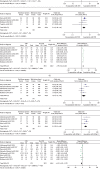Prevalence and Predictors of Contrast-Induced Nephropathy (CIN) in Patients with ST-Segment Elevation Myocardial Infarction (STEMI) Undergoing Percutaneous Coronary Intervention (PCI): A Meta-Analysis
- PMID: 31772520
- PMCID: PMC6854223
- DOI: 10.1155/2019/2750173
Prevalence and Predictors of Contrast-Induced Nephropathy (CIN) in Patients with ST-Segment Elevation Myocardial Infarction (STEMI) Undergoing Percutaneous Coronary Intervention (PCI): A Meta-Analysis
Abstract
Background: Contrast-induced nephropathy (CIN) becomes more and more frequent after percutaneous coronary intervention (PCI) in patients with ST-segment elevation myocardial infarction (STEMI). There have been no reported meta-analyses to determine the role of these risk factors in predicting CIN in patients with STEMI undergoing PCI. So we made this meta-analysis to summarize the incidence of CIN in patients with STEMI undergoing PCI and to study associations between CIN and several risk factors that are mentioned in most prevention guidelines.
Hypothesis: The overall incidence of CIN in patients with STEMI undergoing PCI is not low. Many risk factors could influence the occurrence of CIN, such as hypertension, diabetes mellitus (DM), and lower estimated glomerular filtration rate.
Methods: Databases, including PubMed, Embase, Cochrane Library, China National Knowledge Infrastructure (CNKI), and Chinese BioMedical (CBM), were searched for articles published before May 21, 2019, to identify all relevant studies on CIN. The pooled data were analyzed using either fixed-effects or random-effects models depending on heterogeneity (assessed via the I 2 index).
Results: Twelve articles encompassing a total of 6342 patients were included. The overall pooled CIN incidence was 13.3% (95% CI: 10.4-17.1). The forest plots showed positive associations between CIN and the presence of hypertension, diabetes mellitus, history of prior myocardial infarction, age, damaged left anterior descending artery, Killip class ≥2, decreased left ventricular ejection fraction, lower estimated glomerular filtration rate, and left ventricular ejection fraction <40%; the odds ratios for these factors were 1.85 (95% CI: 1.57-2.18; p < 0.00001), 1.83 (95% CI: 1.47-2.29; p < 0.00001), 2.14 (95% CI: 1.46-3.14; p < 0.0001), 7.79 (95% CI: 5.24-10.34; p < 0.00001), 1.92 (95% CI: 1.15-3.22; p=0.01), 3.12 (95% CI: 2.21-4.40; p < 0.00001), -6.15 (95% CI: -9.52 to -2.79; p=0.0003), -15.06 (95% CI: -24.75 to -5.36; p=0.002), and 5.53 (95% CI: 1.10-27.95; p=0.04), respectively.
Conclusion: The overall incidence of CIN in patients with STEMI undergoing PCI was not low and was closely associated with hypertension, diabetes mellitus, history of prior myocardial infarction, age, damaged left anterior descending artery, Killip class ≥2, decreased left ventricular ejection fraction, lower estimated glomerular filtration rate, and left ventricular ejection fraction <40%.
Copyright © 2019 Huan He et al.
Conflict of interest statement
The authors declare that there are no conflicts of interest.
Figures


References
-
- Uyarel H., Nese C., Ergelen M., et al. Contrast-induced nephropathy in patients undergoing primary angioplasty for acute myocardial infarction: incidence, a simple risk score, and prognosis. Archives of Medical Science. 2009;5(4):550–558.
-
- Ako J., Morino Y., Okuizumi K., Usami M., Nakamura M. Japanese postmarketing surveillance of clopidogrel in patients with non-ST-segment elevation acute coronary syndrome, stable angina, old myocardial infarction, and ST-segment elevation myocardial infarction after percutaneous coronary intervention in a real-life setting: the final report (J-PLACE Final) Cardiovascular Intervention and Therapeutics. 2016;31(2):101–113. doi: 10.1007/s12928-015-0355-z. - DOI - PubMed
-
- Demircelik M. B., Kurtul A., Ocek H., Cakmak M., Ureyen C., Eryonucu B. Association between platelet-to-lymphocyte ratio and contrast-induced nephropathy in patients undergoing percutaneous coronary intervention for acute coronary syndrome. Cardiorenal Medicine. 2015;5(2):96–104. doi: 10.1159/000371496. - DOI - PMC - PubMed
Publication types
MeSH terms
Substances
LinkOut - more resources
Full Text Sources
Miscellaneous
